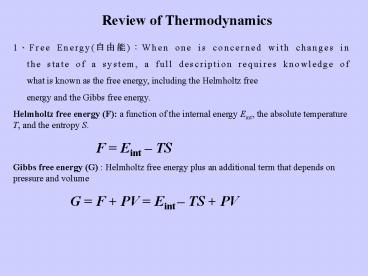Review of Thermodynamics - PowerPoint PPT Presentation
1 / 20
Title:
Review of Thermodynamics
Description:
the state of a system, a full description requires knowledge of ... Internal Energy (Eint), Enthalpy (H), Helmholtz Free Energy (F), Gibbs Free energy (G) ... – PowerPoint PPT presentation
Number of Views:141
Avg rating:3.0/5.0
Title: Review of Thermodynamics
1
Review of Thermodynamics
1?Free Energy(???)When one is concerned with
changes in the state of a system, a full
description requires knowledge of what is
known as the free energy, including the Helmholtz
free energy and the Gibbs free
energy. Helmholtz free energy (F) a function of
the internal energy Eint, the absolute
temperature T, and the entropy S.
F Eint TS Gibbs free
energy (G) Helmholtz free energy plus an
additional term that depends on pressure and
volume G F PV
Eint TS PV
2
2?Equilibrium conditionsthe general rule is that
a system can spontaneously alter its
status if the change results in a lowering
of the free energy. Therefore the equilibrium
condition is that the free energy of the
system is minimized. For a mechanically isolated
system at constant temperature (no work)
?F ? 0 ( holds at
equilibrium ) For a system kept at constant
temperature and pressure
?G ? 0 ( holds at equilibrium )
3
Thermodynamic Potentials Internal Energy
(Eint), Enthalpy (H), Helmholtz Free Energy (F),
Gibbs Free energy (G)
H Eint PV, F Eint-TS, G Eint-TSPV
Maxwell Relations
4
3?Example of the principle of minimizing free
energy. Consider an isolated ideal gas system
consisting of two compartments of volume V1 and
V2, respectively. The boundary between these two
compartments is free to move Find the equilibrium
condition. Sol For an isolated system, the
equilibrium condition is
-P1
-P2
Equilibrium conditionP1P2
5
4?Internal Energy Consider two atoms in
equilibrium
Ekin 0 Epot 0
Small perturbation t 0
6
For a system of N particles
equipartition theorem
kB 1.38?10-23JK-1Boltzmann constant 3N degrees
of freedom Each degree of freedom ½ kB T
7
5?Entropy (S) S kB ln ? ?number of
available states a state involves both the
positions and the velocities of all the atoms in
the system. Example Consider a harmonic
oscillator Its Hamiltonian is
k
m
p momentum q position
phase space
Total available area in phase space ?W Unit
area in p-q phase space due to uncertainty
principle is h Number of states ? ?W/h
p
E
q
For a system of N particles in 3-D space
? (E,V,N) ?W(E)/h3N
E ?E
8
Example 2A container is divided into two parts
by a barrier that has a small hole in it. The gas
molecules are indistinguishable.
(b)
(a)
n1
n2
N n1 n2
9
Consider a system that is described by a set of
states 1, 2, 3, ...., i,.... with corresponding
energies ?1, ?2, ?3, ?i, Let the number of
particles in state 1 be n1, in state 2 be n2,
and so on. Total number of particles Number
of different ways
Maximizing entropy with the constraints of
particle number and total energy, we get
10
partition function
At equilibrium, the probability to jump from
state i to state j is
(detail balance)
11
Connection between free energy and partition
function Define F -NkBTlnZ what is F?
if F is the Helmholtz free energy
12
Reaction Kinetics
fist order
second order
reaction flux Jck2C ,
JAJBk1AB
chemical potential of a given component
A more general reaction is
the change in the Gibbs free energy
activation energy
13
Water-- Mercedes-Benz model
The near-tetrahedral structure of the water
molecule provides the basis for the most common
crystal structure of ice. Hydrogen bonds in
liquid water are perpetually being formed and
broken. The hydrophobicity of a non-polar
molecule arises due to the reduced entropy of
water in the presence of such a non-polar
object, which plays an important role in biology.
To study water, the MB model in 2-d provides a
simplified view of ordering the water
configurations in the presence of an ion or a
non-polar molecule.
14
Molecular Interactions
water-water interaction
van der Waals term
Hydrogen bonding term
ion-water interaction
15
water distribution
16
Average number of hydrogen bonds within the first
water shell around an ion
17
(No Transcript)
18
(No Transcript)
19
(No Transcript)
20
(No Transcript)

